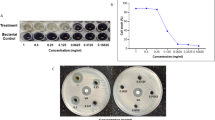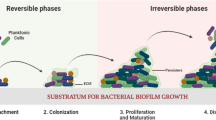Abstract
Staphylococcus aureus (S.aureus) is both a colonizer as well as a human pathogen that causes a variety of diseases. Mupirocin is a topical antimicrobial agent which is very effective against S.aureus infection. However, treating the S.aureus infection using mupirocin could be complicated due to biofilm formation. Consequently, resistance to mupirocin occurs and leads to chronic infection. The combination of mupirocin with a compound that has biofilm eradicating effect would be an ideal solution for effectively treating biofilm infections. Therefore, in this study, we have investigated the biofilm inhibitory and eradication effect of mupirocin with three essential oils (Cinnamon Oil (CO), Eugenol (EU) and Eucalyptus Oil (EO)) against sessile S.aureus. From these preliminary results, it was found that the mupirocin-CO (0.2 µg/ml-5.218 mg/ml) combination has a better synergistic antibiofilm effect against sessile S.aureus and the fractional inhibitory concentration index was found to be 0.458. The best combination of mupirocin with CO was loaded into a non-greasy O/W cream. The physico-chemical and microbiological evaluations were carried out for the prepared cream. The prepared cream has better biofilm eradication activity (40%) when compared to a marketed cream (20%).





Similar content being viewed by others
References
Archer NK, Mazaitis MJ, Costerton JW, Leid JG, Powers ME, Shirtliff ME (2011) Staphylococcus aureus biofilms: properties, regulation, and roles in human disease. Virulence 2(5):445–459
Hall-Stoodley L, Costerton JW, Stoodley P (2004) Bacterial biofilms: from the natural environment to infectious diseases. Nat Rev Microbiol 2(2):95–108
Hurler J, Sørensen KK, Fallarero A, Vuorela P, Škalko-Basnet N (2013) Liposomes-in-hydrogel delivery system with mupirocin: in vitro antibiofilm studies and in vivo evaluation in mice burn model. Biomed Res Int 2013:1–8
Kifer D, Muzinic V, Klaric MS (2016) Antimicrobial potency of single and combined mupirocin and monoterpenes, thymol, menthol and 1, 8-cineole against Staphylococcus aureus planktonic and biofilm growth. J Antibiot 69(9):689–696
Mah TFC, O’Toole GA (2001) Mechanisms of biofilm resistance to antimicrobial agents. Trends Microbiol 9(1):34–39
Mahalakshmi M, Sankar V (2020) In vıtro antıbacterıal effect of mupırocın ın combınatıon wıth three essentıal oıls agaınst staphylococcus aureus. IJPSR 11(2):705–709
Rafiee-Tehrani M, Mehramizi A (2000) In vitro release studies of piroxicam from oil-in-water creams and hydroalcoholic gel topical formulations. Drug Dev Ind Pharm 26(4):409–414
ReiB S, Pané-Farré J, Fuchs S, François P, Liebeke M, Schrenzel J, Lindequist U, Lalk M, WolzC HM, Engelmann S (2012) Global analysis of the Staphylococcus aureus response to mupirocin. Antimicrob Agents Chemother 56(2):787–804
Roy R, Tiwari M, Donelli G, Tiwari V (2018) Strategies for combating bacterial biofilms: a focus on anti-biofilm agents and their mechanisms of action. Virulence 9(1):522–554
Thomas CM, Hothersall J, Willis CL, Simpson TJ (2010) Resistance to and synthesis of the antibiotic mupirocin. Nat Rev Microbiol 8(4):281–289
Acknowledgements
We would like to thank the Principal, PSG College of Pharmacy and PSG Insitute of Medical Sciences and Research for providing necessary facilities to do the work. We also thank Fourts India, Stedman Pharmaceuticals Pvt Ltd Chennai for providing free gift sample of Mupriocin and Council of Scientific and Industrial Research, New Delhi for providing a major extramural research grant to initiate the preliminary research work (Grant. No: 60(0117)/19/EMR-II). We also acknowledge The Tamil Nadu Dr.M.G.R. Medical University, Chennai, India for providing minor research grant and Dr Sivaram Hariharan for English proofreading and editing.
Author information
Authors and Affiliations
Corresponding author
Ethics declarations
Conflict of interest
The author reports no conflicts of interest. The author alone is responsible for the content and writing of the article.
Additional information
Communicated by Erko Stackebrandt.
Publisher's Note
Springer Nature remains neutral with regard to jurisdictional claims in published maps and institutional affiliations.
Rights and permissions
About this article
Cite this article
Sundaramoorthy, M., Karuppaiah, A., Nithyanth, M. et al. Formulation development of cream with mupirocin and essential oils for eradication of biofilm mediated antimicrobial resistance. Arch Microbiol 203, 1707–1715 (2021). https://doi.org/10.1007/s00203-020-02175-5
Received:
Revised:
Accepted:
Published:
Issue Date:
DOI: https://doi.org/10.1007/s00203-020-02175-5




